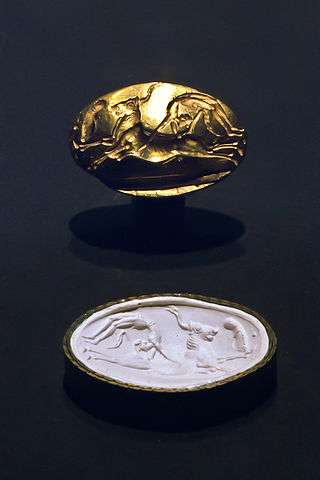Minoan sealstone
Minoan seal-stones are carved gemstones produced in the Minoan civilization. They have been found in quantity at specific sites, for example in Knossos, Mallia and Phaistos.

Minoan seal-stones are of a small size, 'pocket-size', in the manner of a personal amulet. They might be thought of as equivalent to the pocket-sized, 1 inch (3 cm) scaraboid seals of Ancient Egypt. However Minoan seals can be larger, with largest examples of many inches.
Subjects depicted
These include with animals, dance, and goddesses. One common iconographic motif in Minoan art, especially frescoes, is bull-leaping; the example illustrated shows leapers and a bull. Other themes are varied, including for example: 'pottery and a plant'-(with 5 moon/planet crescents), 'confronted-goats', and a 'single bird'.[1]
Significant archaeological finds
In 2015, an international team of archaeologists led by University of Cincinnati researchers discovered the Griffin Warrior Tomb, an undisturbed Bronze Age warrior’s tomb at Pylos in southwestern Greece.[2] The grave contained more than 50 gold or hardstone seal-stones, with intricate carvings in Minoan style showing goddesses, altars, reeds, lions and bulls, some with bull-jumpers soaring over the bull’s horns – all in Minoan style and probably made in Crete.[3] The Pylos Combat Agate is the most remarkable of this.
References
- The March of Archaeology, pg. 63.
- Bronze Age warrior's tomb
- Ceram, C.W. The March of Archaeology, C.W.Ceram, translated from the German, Richard and Clara Winston, (Alfred A. Knopf, New York), c 1958.
 5 Seals—impressions:
5 Seals—impressions:
'Lion taking animal?'
"horse"
?
'5 circles & ?'
??